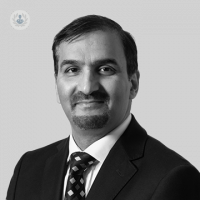Insights into diabetic foot management
Escrito por:In his latest online article, Mr S. Tawqeer Rashid gives us his insights into diabetic foot. He talks about the most effective surgical options for managing a severe diabetic foot ulcer, what the multidisciplinary approach to enhance the treatment would be and the key consideration in selecting between conservative therapy and a surgical intervention.

What are the most effective surgical options for managing a severe diabetic food ulcer?
When it comes to foot ulcers, we usually try to avoid surgery if we can. Diabetic foot ulcers are mainly caused by nerve damage, making it hard for people to feel if there's any damage happening. So, the first thing we do for an ulcer is to take the pressure off the affected area. We use special dressings, footwear, and sometimes a cast to shift the pressure away from the ulcer.
If the ulcer is infected, we treat it with antibiotics, either as pills, intravenous drips, or directly on the sore. Now, when surgery comes into play, it's often because the foot isn't healing well due to poor blood supply. We try to improve blood flow through surgeries like removing plaque from arteries (endarterectomy), creating bypasses to redirect blood, or using wires and balloons to open up blocked arteries from the inside (endovascular techniques).
Sometimes, if there's infected tissue and it's not healing, we might need to do debridement, which can involve amputations of toes or parts of the foot. Additionally, foot and ankle surgeons might do procedures to change the foot's shape using things like tendon adjustments or joint corrections. These are the usual ways we deal with diabetic foot ulcers.
What would be the multidisciplinary approach to enhance the treatment of a diabetic foot complication?
A diabetic foot ulcer is a condition where teamwork among different medical experts is crucial. The main concern is that about half of these ulcers get infected, and for those with an infection, about 20% might need amputation—half in the foot and half in the leg. There's also a nearly 10% risk of losing a leg within a year if you have a diabetic foot ulcer. To deal with these risks, various specialists need to work together.
There are three main things that increase the risk of amputation: nerve damage, reduced ability to fight infections, and poor blood supply. The teamwork begins by addressing nerve damage through methods like special footwear and sometimes casts. Keeping blood sugar in check is also important and may involve taking medications.
We also look at general health, including things like weight and medications for heart problems. In some clinics, microbiologists help by making sure infections are treated quickly with the right antibiotics. In severe cases, patients might need to stay in the hospital for antibiotics, or they could get them at home. Antibiotics might also be given directly to the foot. Radiologists help us understand how infections are developing, especially in the bone, and scans might be needed for serious infections, leading to surgery.
As a vascular surgeon, I check blood flow using methods like ultrasound scans, ankle-to-arm pressure checks, or, more commonly in diabetic foot cases, by comparing blood supply in the toe to the arm. If we think an intervention is needed, we might use scans like MR angiograms or CT angiograms, or even direct angiograms with a catheter to check if there's a need for treatment before surgery. The team also includes foot and ankle surgeons who help during the initial phase, provide advice on procedures like cleaning or tendon adjustment, and perform surgeries to reshape the foot if there's a risk of a new ulcer, even after healing.
What would be the key consideration in selecting between conservative therapy and a surgical intervention for diabetic patients?
Once again, as is common in medical situations, we conduct a risk-benefit analysis. If you have a healing neuropathic ulcer, we typically stick with conservative measures to facilitate the healing process. However, if there's a risk of recurrence or you're deemed at high risk for it, our foot and ankle surgeons may suggest that leaving the foot as it is could lead to an unacceptably high chance of recurrence.
In the case of neuro-ischemic ulcers, similar principles apply. For instance, if the ulcer is healing, even with evidence of arterial disease, we often refrain from intervention. The decision changes if the ulcer doesn't heal despite attempting various conservative therapies, such as offloading, infection control, and sometimes musculoskeletal surgery. In such cases, when all else has been tried and failed, we will intervene with revascularisation in the presence of ischemia.
Mr S. Tawqeer Rashid is an esteemed vascular surgeon with over 25 years of experience. You can schedule an appointment with Mr Rashid on his Top Doctors profile.


